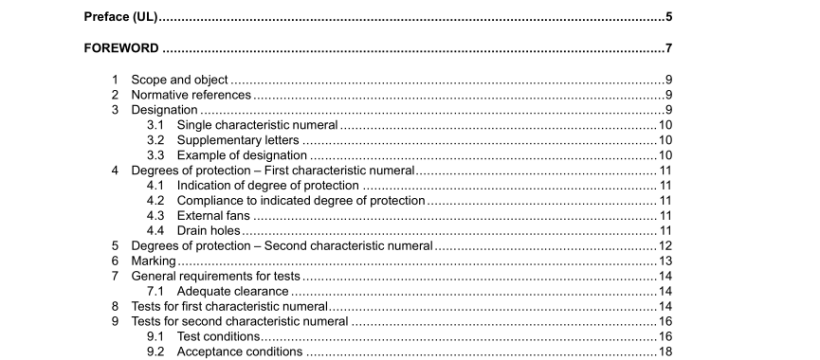UL 60034-5-2019 pdf download.Rotating Electrical Machines – Part 5: Degrees of Protection Provided by the Integral Design of Rotating Electrical Machines (IP Code) – Classification.
4 Degrees of protection – First characteristic numeral 4.1 Indication of degree of protection The first characteristic numeral indicates the degree of protection provided by the enclosure to persons and to the parts of the machine inside the enclosure. Table 2 gives, in the third column, brief details of objects which will be ‘excluded’ from the enclosure for each of the degrees of protection represented by the first characteristic numeral. The term ‘excluded’ implies that a part of the body, a tool or a wire held by a person, either will not enter the machine or, if it enters, that adequate clearance will be maintained between it and the live parts or dangerous moving parts (smooth rotating shafts and the like are not considered dangerous). The third column of Table 2 also indicates the minimum size of solid foreign objects which will be excluded. 4.2 Compliance to indicated degree of protection Compliance of an enclosure with an indicated degree of protection implies that the enclosure will also comply with all lower degrees of protection in Table 2. In consequence, the tests establishing these lower degrees of protection are not required, except in case of doubt. 4.3 External fans The blades and spokes of fans external to the enclosure shall be protected against contact by means of guards complying with Table 1.
5 Degrees of protection – Second characteristic numeral 5.1 The second characteristic numeral indicates the degree of protection provided by the enclosure with respect to harmful effects due to ingress of water. Table 3 gives, in the third column, details of the type of protection provided by the enclosure for each of the degrees of protection represented by the second characteristic numeral. An air-cooled open machine is weather-protected when its design reduces the ingress of rain, snow and airborne particles, under specified conditions, to an amount consistent with correct operation. This degree of protection is designated by the letter W placed after the second characteristic numeral. 5.2 For second characteristic numerals up to and including 6, compliance of an enclosure with an indicated degree of protection implies that the enclosure will also comply with all lower degrees of protection in Table 3. In consequence, the tests establishing these lower degrees of protection are not required, except in case of doubt.
7 General requirements for tests The tests specified in this standard are type tests. They shall be carried out on standard products or models of them. Where this is not feasible, verification either by an alternative test or by examination of drawings shall be the subject of an agreement between manufacturer and user. Unless otherwise specified, the machine for each test shall be clean with all the parts in place and mounted in the manner stated by the manufacturer. In the case of both first and second characteristic numerals 1, 2, 3 and 4, a visual inspection may, in certain obvious cases, show that the intended degree of protection is obtained. In such cases, no test need be made. However, in case of doubt, tests shall be made as prescribed in clauses 8 and 9. 7.1 Adequate clearance For the purpose of the following test clauses in this standard, the term ‘adequate clearance’ has the meaning given in 7.1.1 or 7.1.2. 7.1.1 Low-voltage machines (rated voltages not exceeding 1 000 Va.c. and 1 500 V d.c.) The test device (sphere, finger, wire, etc.) does not touch the live parts or moving parts other than non- dangerous parts such as smooth rotating shafts. 7.1.2 High-voltage machines (rated voltages exceeding 1 000 Va.c. and 1 500 V d.c.) When the test device is placed in the most unfavourable position, the machine shall be capable of withstanding the dielectric test applicable to the machine.UL 60034-5-2019 pdf download.
UL 60034-5-2019 pdf download
